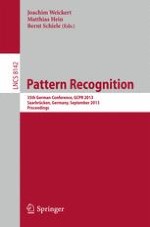This book constitutes the refereed proceedings of the 35th German Conference on Pattern Recognition, GCPR 2013, held in Saarbrücken, Germany, in September 2013. The 22 revised full papers and 18 revised poster papers were carefully reviewed and selected from 79 submissions. The papers covers topics such as image processing and computer vision, machine learning and pattern recognition, mathematical foundations, statistical data analysis and models, computational photography and confluence of vision and graphics, and applications in natural sciences, engineering, biomedical data analysis, imaging, and industry.
